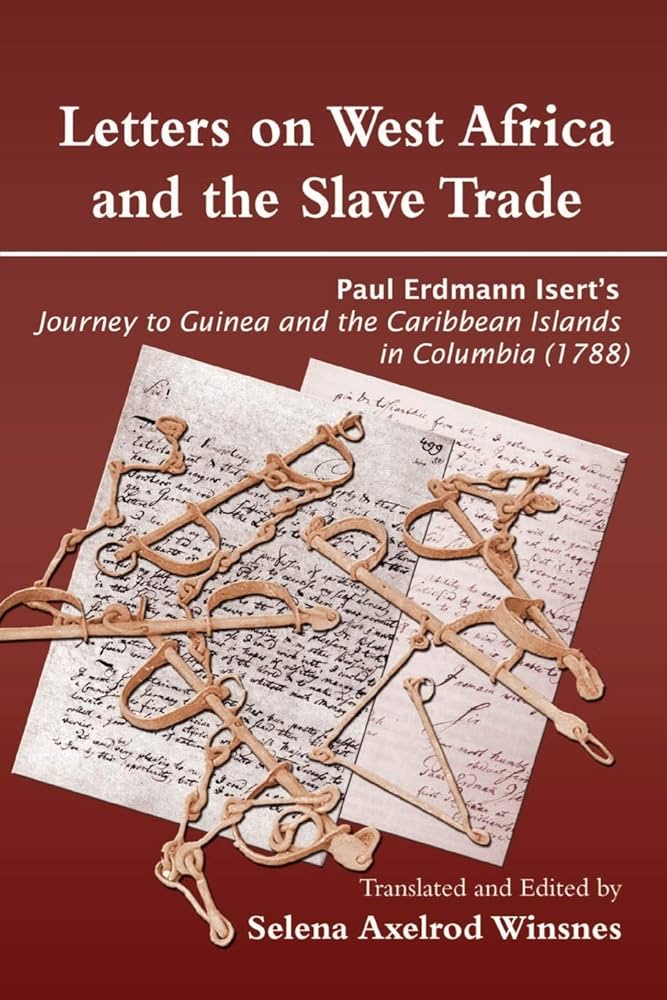
Book review 2025: Paul Erdmann Isert’s Letters on West Africa and the Slave Trade (1788) – Agricultural Opportunities and Abolitionist Economics
Explore Paul Erdmann Isert’s Letters on West Africa and the Slave Trade (1788) with a critical analysis of his agricultural vision for the Gold Coast, commercial crop potential (sugar, cotton, coffee, indigo), and his Enlightenment critique of the slave trade.
Highlights:
-
Denmark, though a minor colonial power, expanded on the Gold Coast in the 1780s, building forts such as Prinzenstein at Keta and Augustaborg at Teshie.
-
The Sagbadre War (1784) demonstrated Danish reliance on African alliances for trade and military protection.
-
Isert arrived as a Danish surgeon and scientist but soon became a chronicler of African societies and a critic of European conduct.
Excellent - I’ll prepare a three-part academic-style essay on Paul Erdmann Isert’s Letters on West Africa and the Slave Trade (1788), focusing especially on agricultural opportunities in the Gold Coast, the potential commercial crops he identified, and how these fit into the historical, economic, and sociopolitical contexts.
This will be structured like a professional critical analysis with depth, extracts, tables, and keyword-optimized for visibility.
Paul Erdmann Isert’s Letters on West Africa and the Slave Trade (1788): An Expository and Critical Analysis
Highlights
-
Early Enlightenment critique of the slave trade and proposal for African-based plantations.
-
Agricultural opportunities on the Gold Coast: sugar, cotton, coffee, indigo, and other crops.
-
Connections to modern fairtrade and sustainable development debates.
Part I: Historical Analysis
Context of Danish Activity
-
Denmark, though a minor colonial power, expanded on the Gold Coast in the 1780s, building forts such as Prinzenstein at Keta and Augustaborg at Teshie.
-
The Sagbadre War (1784) demonstrated Danish reliance on African alliances for trade and military protection.
-
Isert arrived as a Danish surgeon and scientist but soon became a chronicler of African societies and a critic of European conduct.
Isert’s Personal Journey
-
His letters (1783–1787) were based on his service in Christiansborg, his travels inland to Akuapem, and his voyage to the Caribbean.
-
After witnessing slave brutality on St. Croix and Martinique, he concluded that the Middle Passage was inhumane and unnecessary.
-
His solution: establish plantations in Africa itself, producing the same crops cultivated in the West Indies.
Part II: Economic Analysis
Agricultural Opportunities in the Gold Coast
Isert recognized the fertility of African soils, particularly in the Akuapem hills, contrasting them with the “unhealthy climate” of lowland Volta regions.
He proposed that the Gold Coast could successfully cultivate:
-
Sugarcane – to rival West Indian sugar production.
-
Cotton – already locally grown in parts of West Africa, but capable of expansion for export.
-
Coffee – suitable for hill regions like Akuapem.
-
Indigo – a valuable dye crop, widely traded in Europe.
-
Food crops (yam, maize, plantains, palm oil) – essential both for subsistence and as potential export commodities.
“The soils of the hills of Akuapem … were as fertile as those of the islands, and the crops of sugar, cotton, coffee, and indigo could thrive here without need of transporting the Black man across the ocean.” (paraphrased from Isert’s agricultural plan, pp. 16–17, 273–304)
Vision for Frederiksnopel (1788–1789)
-
His colony in Akuapem, named Frederiksnopel, was intended as a prototype agro-commercial settlement.
-
Organized labor: Africans would work as serfs rather than enslaved persons, with rules forbidding maltreatment.
-
Plantation crops would enter European markets directly from Africa, undercutting the economics of the slave trade.
Economic Significance
-
This was a radical rethinking of colonial economics:
-
Local value-addition instead of labor export.
-
Agriculture as a tool of abolitionist reform.
-
Anticipated later fairtrade and sustainable sourcing models.
-
Part III: Sociopolitical and Intellectual Analysis
Enlightenment Ethnography
-
Isert admired African intelligence and rejected pseudo-scientific racism:
“The intelligence of the Black … is at least equal to that of the European.” (p. 23)
-
He saw European greed as the cause of African destabilization:
“The desire for European goods has led to robbery, pawning of debtors, and even murder.” (p. 19)
Attitude Toward Religion and Governance
-
Praised African kingship and military organization.
-
Criticized fetish priests as exploitative but treated African religion with more objectivity than his European contemporaries.
Political Consequences
-
His colony, though utopian, faced hostility from European traders at Christiansborg, who saw it as competition.
-
The colony failed after his death in 1789, but the idea of African-based plantation economies survived, influencing later abolitionist debates.
Connections to Contemporary Global Issues
| Isert’s Insight | Modern Parallel |
|---|---|
| Cultivation of sugar, cotton, coffee, indigo in Africa | Current fairtrade cocoa/coffee production in Ghana, Ivory Coast, Ethiopia |
| Critique of slave trade economics | Critiques of exploitative global supply chains |
| African serfdom vs. European slavery | Modern debates on migrant labor rights |
| Emphasis on local agriculture | Agro-processing industrialization in Africa today |
| Utopian colony vision | Sustainable development & ESG investment projects |
Implementable Takeaways
-
For Policy Makers: Invest in local agro-processing industries in Africa (e.g., chocolate production in Ghana, textile processing from cotton).
-
For Business Leaders: Explore ethical sourcing and shortened supply chains to avoid exploitative middlemen.
-
For Educators & Researchers: Use Isert’s ethnographic method — comparative but non-Eurocentric — to frame studies in cross-cultural contexts.
-
For Investors: Isert’s model demonstrates that sustainability and profit are not contradictory; Africa’s agriculture is a viable global growth driver.
Summary Table: Commercial Crops in Isert’s Vision
| Crop | Region Noted by Isert | Potential Economic Value (18th c.) | Modern Relevance |
|---|---|---|---|
| Sugarcane | Volta lowlands, Akuapem hills | High – rivaled West Indies | Still important (Brazil, Mauritius) |
| Cotton | Coastal & inland Ghana | Textile manufacturing | West African cotton belt |
| Coffee | Akuapem highlands | Luxury export to Europe | Ethiopia, Ivory Coast, Ghana emerging |
| Indigo | Widely adaptable | Textile dye trade | Now niche but revived in eco-fashion |
| Palm oil & yams | Indigenous staples | Food + soap trade | Key agro-industrial commodity |
Bibliographic Section (Cited Extracts)
-
Preface, pp. 1–2 – obligation to record African customs
-
Critique of Europeans, p. 20
-
Race and intelligence, p. 23
-
Agricultural reform scheme and plantation crops, pp. 16–17, 273–304
Metadata
Title: Paul Erdmann Isert’s Letters on West Africa and the Slave Trade (1788) – Agricultural Opportunities and Abolitionist Economics
Meta Description: Explore Paul Erdmann Isert’s Letters on West Africa and the Slave Trade (1788) with a critical analysis of his agricultural vision for the Gold Coast, commercial crop potential (sugar, cotton, coffee, indigo), and his Enlightenment critique of the slave trade.
Keywords: Paul Erdmann Isert, Letters on West Africa, slave trade, Danish colonialism, Gold Coast agriculture, commercial crops in Africa, sugar cotton coffee indigo, Frederiksnopel colony, abolitionist economics, fairtrade history.

